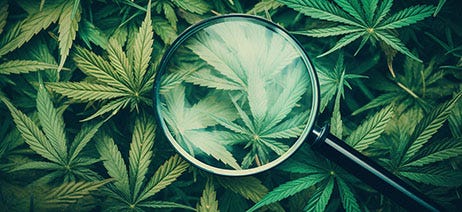
Everything You Need to Know About the Marijuana Plant
Did you know that there is more than just one type of marijuana plant? This guide will help you not only understand the different types of marijuana plants, but also where they are grown and the specific parts of the marijuana plant including:
- The History of the Cannabis Plant
- The Difference Between Male and Female Plants
- The Anatomy of the Cannabis Plant
- FAQs About the Cannabis Plan
History of the Cannabis Plant
Cannabis has a rich history dating back at least 2500 years in what is now central China. Initially cultivated for practical purposes, like making rope, paper, and clothing, it quickly entered the realm of ancient medicine. As cannabis awareness spread, its medicinal applications did as well. By the 19th century, it was a common ingredient across the continents. However, its respect and use suffered a serious setback in the United States in the mid-20th century as regulatory restrictions grew. It would not be until the mid-1990s that legalization for medical purposes and later recreation would gain steam at a state level across the country.1
As the popularity of cannabis grew, different regions developed different strains based on what grew best due to climate, elevation, and soil factors. Regional variants include what are called landrace strains today, such as the Hindu Kush of Pakistan.2


Male vs Female Plants
Male and female marijuana plants are not created equal. While both are important in the growth cycle, the female plants are the ones responsible for producing cannabis buds.3
Female Marijuana Plant
Female marijuana plants are highly valued for their ability to produce cannabis buds that contain high concentrations of cannabinoids and terpenes. These buds, which develop at the nodes along the plant’s branches, are resinous with a dense, sticky texture. Female plants can be identified by their small, white pistils, which are hair-like structures that emerge from the nodes. These pistils are the reproductive organs of the plant, which also indicate the plant’s potential to produce the much-desired buds.3
Male Marijuana Plant
Male marijuana plants, on the other hand, can be identified by their pollen sacs, which look like small, round clusters. These sacs are responsible for producing and dispersing pollen, which fertilizes female plants and leads to seed production. Male plants, however, do not develop the resinous buds, but focus on producing pollen.3
Anatomy of the Cannabis Plant
Cannabis plants have a unique, often-recognized plant structure. Cannabis leaves sprout from a long, thin stem that’s covered with nodes. Wondering what each of these parts of the plant look like and how they contribute to the growing cycle? Here is more information about the biology of our favorite plant:
Flower
Marijuana flower is so complex that researchers are still trying to understand exactly all the compounds that exist within these unique plants, as well as how they may affect our bodies. However, we do know that there are hundreds of bioactive or psychoactive chemical compounds produced in the trichomes of the cannabis flower.4 In fact, you have likely heard of a few of these and not realized it!
Trichomes
Cannabis trichomes are resin glands that decorate the surface of marijuana leaves and flower buds. They’re sticky and shiny, and they usually have a strong aroma that can be pungent, sweet, woodsy, and more. While they look like little hairs, they’re actually tiny factories that produce all of the incredible cannabinoids, terpenes, and flavonoids
Cannabinoids
Cannabinoids are bioactive compounds secreted by the plant’s trichomes. Scientists have discovered over 100 known cannabinoids, but you’ve likely heard of a few as well–specifically THCA (which becomes THC) and CBDA (which becomes CBD).5
Terpenes
Cannabis flower buds contain terpenes, chemical compounds that produce distinctive tastes and smells. These fascinating chemicals also contribute to the Entourage Effect, a theory that suggests the different properties of the cannabis plant work together to influence your body’s endocannabinoid system.6
Flavonoids
Flavonoids sounds like it refers to "flavor," but the term actually comes from a Latin root that means the color yellow. Flavonoids can create many colors in a plant, and in the cannabis flower, they include anthocyanins – chemical compounds that create purple, red, or blue colors in strains like Purple Haze and Blue Dream.
Cola
The cola refers to a cluster of buds. Plants have many of these closely-knit groups, but one stands out as the primary cluster, positioned at the top of the plant.7 The cola is sometimes also called “bud site” and it contains:5


- Cannabis flower: This consumable part contains various compounds: trichomes (multicellular appendages that produce cannabinoids), cannabinoids (chemicals of the cannabis plant responsible for various psychoactive and non-psychoactive effects), terpenes (plant compounds that produce distinct plant scents), and the reproductive elements of the female plant.
- Sugar leaves: These small, colorful leaves found all over the flower contain very little trichomes, and are often saved to make trim.
- Bract: These tiny leaves protect the reproductive parts of a female plant, safeguarding the seed pod.
- Pistil and stigma: The pistil is the primary reproductive part of the female plant and includes an ovule (seed sac). Thin hair-like structures from the bract will catch the male pollen.
Outside of the cola, other important plant parts support its function.5
Other Key Parts of the Cannabis Plant
- Node: This is the point at which the stem connects to the leaves. It first indicates to growers whether a plant is male or female. The male will grow pollen sacs instead of flowers.7
- Stalk or Stalk: The stem holds the plant structures up and transports nutrients and water into those structures so they can grow and develop properly.8
- Fan Leaves: These iconic leaves are usually discarded.
Types of Cannabis Plants
Cannabis plants are primarily categorized by one of three types: indica, sativa, and hybrid.8
- Indica strains grow short and fast as they are native to colder climates with short growing seasons. They are associated with relaxation and sedative effects; however, individual reactions can vary.10
- Sativa strains tend to grow tall and take longer to mature. They are associated with energizing effects.10
- Hybrid plants are developed through the combination of sativa and indica genetic materials. In other words, the male and female plants came from different types (sativa, indica, or another hybrid).10


Hemp
Hemp refers to non-intoxicating cannabis varieties most commonly used for fiber, which can be used in textiles. To be classified as hemp, a cannabis plant must have no more than 0.3% THC, the primary psychoactive compound in cannabis, and should, therefore, provide no psychoactive effects.8


Frequently Asked Questions
Now that you know the basics about cannabis plants, you may have more questions. Here are some of the frequent questions we hear at our dispensary and answers to these questions.
Is cannabis a weed?
Cannabis is a native-growing plant which can grow wild without human intervention. It can, therefore, be classified as a weed depending on the definition used.
Can you smoke marijuana leaves?
You can, and it is technically possible to experience psychoactive effects. However, the amount of THC found within marijuana leaves is very small, so you would need a lot of leaves to experience any effects.11
What's the difference between indica and sativa?
Indica is a fast-growing, cold-weather climatized cannabis plant, while sativa is acclimated to longer growing seasons and grows taller. Indica is believed to have more relaxing effects, while sativa is believed to be uplifting. However, individual responses vary. Modern research suggests these effects are more accurately attributed to specific cannabinoids and terpenes rather than the plant type itself.10


Learn More About the Cannabis Plant
Now that you know more about the anatomy of a cannabis plant, you can learn more about what’s available and the strain that’s right for you by chatting with the budtender at your local dispensary.
Sources:
1. "History of Cannabis," endocannabinoidmedicine.com, https://www.endocannabinoidmedicine.com/history-of-cannabis/
2. "Origins of Weed," leafly.com, https://www.leafly.com/news/cannabis-101/origins-of-weed
3. "Female vs Male Weed Plants," leafwell.com, https://leafwell.com/blog/female-vs-male-weed-plants
4. “Cannabis, a complex plant: different compounds and different effects on individuals,” Therapeutic Advances in Psychopharmacology, December 2012, https://www.ncbi.nlm.nih.gov/pmc/articles/PMC3736954/
5. “Cannabis Glandular Trichomes: A Cellular Metabolite Factory,” Frontiers in Plant Science, September 2021, https://www.ncbi.nlm.nih.gov/pmc/articles/PMC8488169/
6. “Taming THC: potential cannabis synergy and phytocannabinoid-terpenoid entourage effects,” British Journal of Pharmacology, August, 2011, https://www.ncbi.nlm.nih.gov/pmc/articles/PMC3165946/
7. "Marijuana Plant Anatomy," leafly.com, https://www.leafly.com/learn/growing/marijuana-plant-anatomy
8. “Taming THC: potential cannabis synergy and phytocannabinoid-terpenoid entourage effects,” British Journal of Pharmacology, August, 2011, https://www.ncbi.nlm.nih.gov/pmc/articles/PMC3165946/
9. "Parts of Cannabis Plant," weedmaps.com, https://weedmaps.com/learn/the-plant/parts-of-cannabis-plant
10. "Differences Between Cannabis Types," leafly.com, March 14, 2023, https://www.leafly.com/news/cannabis-101/sativa-indica-and-hybrid-differences-between-cannabis-types
11. "Can Leaves Get You High?" cannaconnection.com, https://www.cannaconnection.com/blog/11497-can-leaves-get-you-high










